RMIT BUSM4613 Project Plan: Website Development for Target Australia
VerifiedAdded on 2022/08/16
|23
|2955
|206
Project
AI Summary
This project plan details the development of a website for Target Australia, outlining a 108-day project timeline commencing on January 6, 2020, and concluding on June 3, 2020. The project, managed using agile methodology, aims to enhance online customer experience and streamline company processes. The plan encompasses five key project management techniques: network diagrams, bar charts, critical path method (CPM), PERT analysis, and cash flow management, all utilized to ensure the project's timely and cost-effective completion. The scope focuses on identifying critical activities, managing project dependencies, and monitoring financial inflows and outflows, with an estimated budget of $142,320. The plan includes detailed network diagrams illustrating task dependencies, bar charts representing activity timelines, and CPM analysis highlighting critical paths. PERT analysis is used to predict project completion time, and cash flow management strategies are implemented to assess the financial health of the project. The project is currently at 64% completion, with an actual cost of $95,400.80 against a BCWP of $21,080.00.

Running head: PROJECT MANAGEMENT
Stage 2: Development of website for Target Australia
Name of the Student:
Name of the University:
Stage 2: Development of website for Target Australia
Name of the Student:
Name of the University:
Paraphrase This Document
Need a fresh take? Get an instant paraphrase of this document with our AI Paraphraser
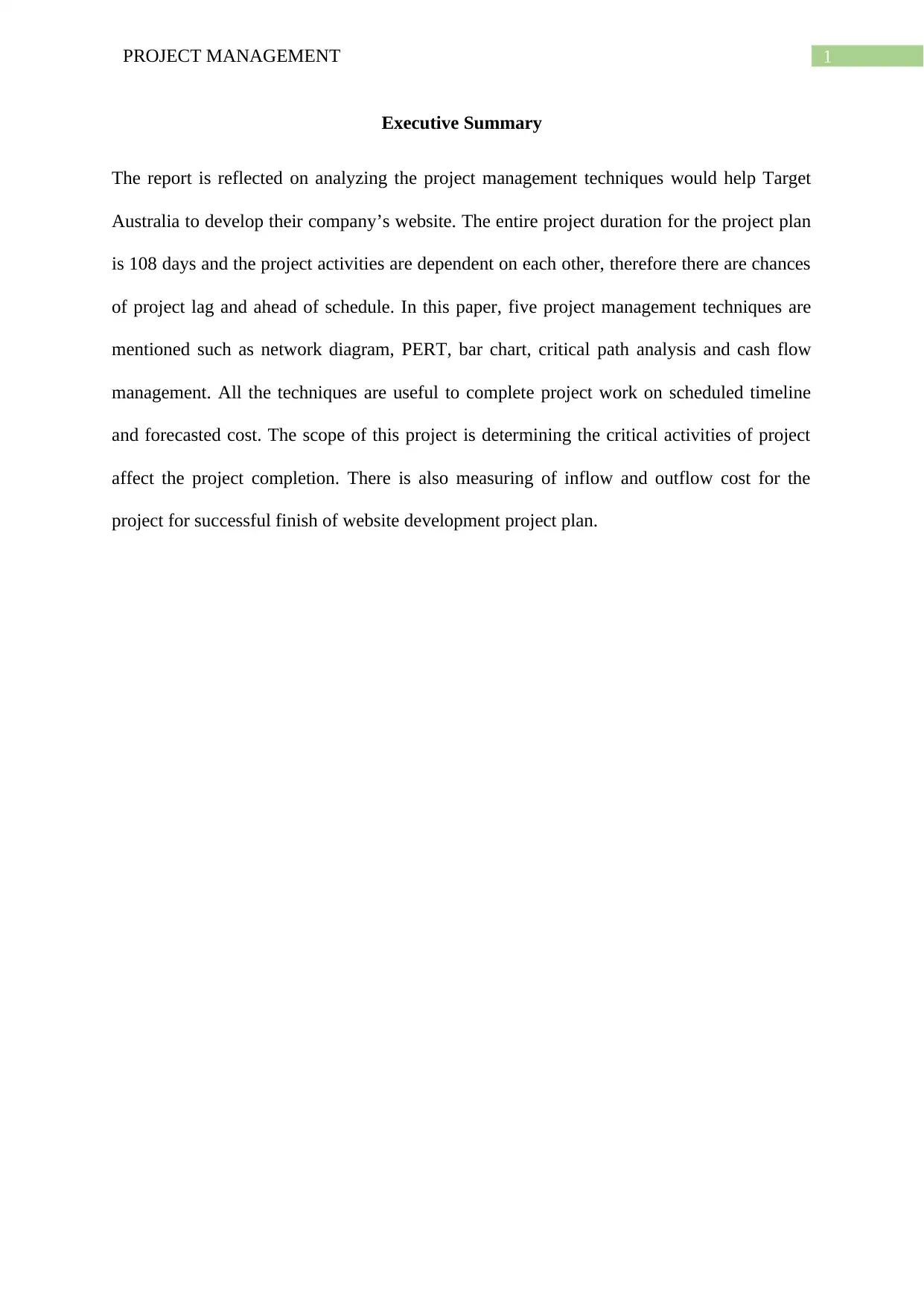
1PROJECT MANAGEMENT
Executive Summary
The report is reflected on analyzing the project management techniques would help Target
Australia to develop their company’s website. The entire project duration for the project plan
is 108 days and the project activities are dependent on each other, therefore there are chances
of project lag and ahead of schedule. In this paper, five project management techniques are
mentioned such as network diagram, PERT, bar chart, critical path analysis and cash flow
management. All the techniques are useful to complete project work on scheduled timeline
and forecasted cost. The scope of this project is determining the critical activities of project
affect the project completion. There is also measuring of inflow and outflow cost for the
project for successful finish of website development project plan.
Executive Summary
The report is reflected on analyzing the project management techniques would help Target
Australia to develop their company’s website. The entire project duration for the project plan
is 108 days and the project activities are dependent on each other, therefore there are chances
of project lag and ahead of schedule. In this paper, five project management techniques are
mentioned such as network diagram, PERT, bar chart, critical path analysis and cash flow
management. All the techniques are useful to complete project work on scheduled timeline
and forecasted cost. The scope of this project is determining the critical activities of project
affect the project completion. There is also measuring of inflow and outflow cost for the
project for successful finish of website development project plan.
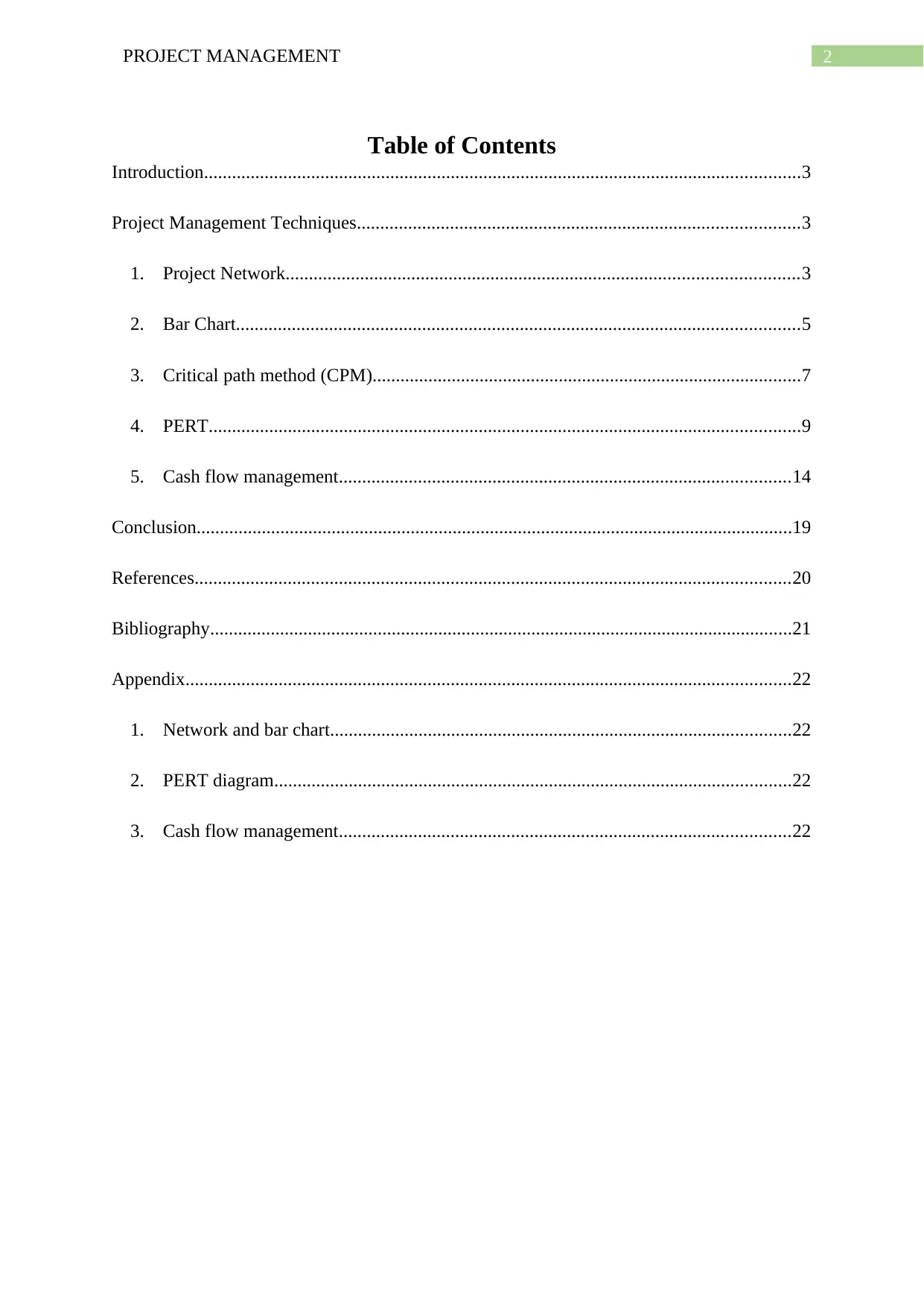
2PROJECT MANAGEMENT
Table of Contents
Introduction................................................................................................................................3
Project Management Techniques...............................................................................................3
1. Project Network..............................................................................................................3
2. Bar Chart.........................................................................................................................5
3. Critical path method (CPM)............................................................................................7
4. PERT...............................................................................................................................9
5. Cash flow management.................................................................................................14
Conclusion................................................................................................................................19
References................................................................................................................................20
Bibliography.............................................................................................................................21
Appendix..................................................................................................................................22
1. Network and bar chart...................................................................................................22
2. PERT diagram...............................................................................................................22
3. Cash flow management.................................................................................................22
Table of Contents
Introduction................................................................................................................................3
Project Management Techniques...............................................................................................3
1. Project Network..............................................................................................................3
2. Bar Chart.........................................................................................................................5
3. Critical path method (CPM)............................................................................................7
4. PERT...............................................................................................................................9
5. Cash flow management.................................................................................................14
Conclusion................................................................................................................................19
References................................................................................................................................20
Bibliography.............................................................................................................................21
Appendix..................................................................................................................................22
1. Network and bar chart...................................................................................................22
2. PERT diagram...............................................................................................................22
3. Cash flow management.................................................................................................22
⊘ This is a preview!⊘
Do you want full access?
Subscribe today to unlock all pages.

Trusted by 1+ million students worldwide
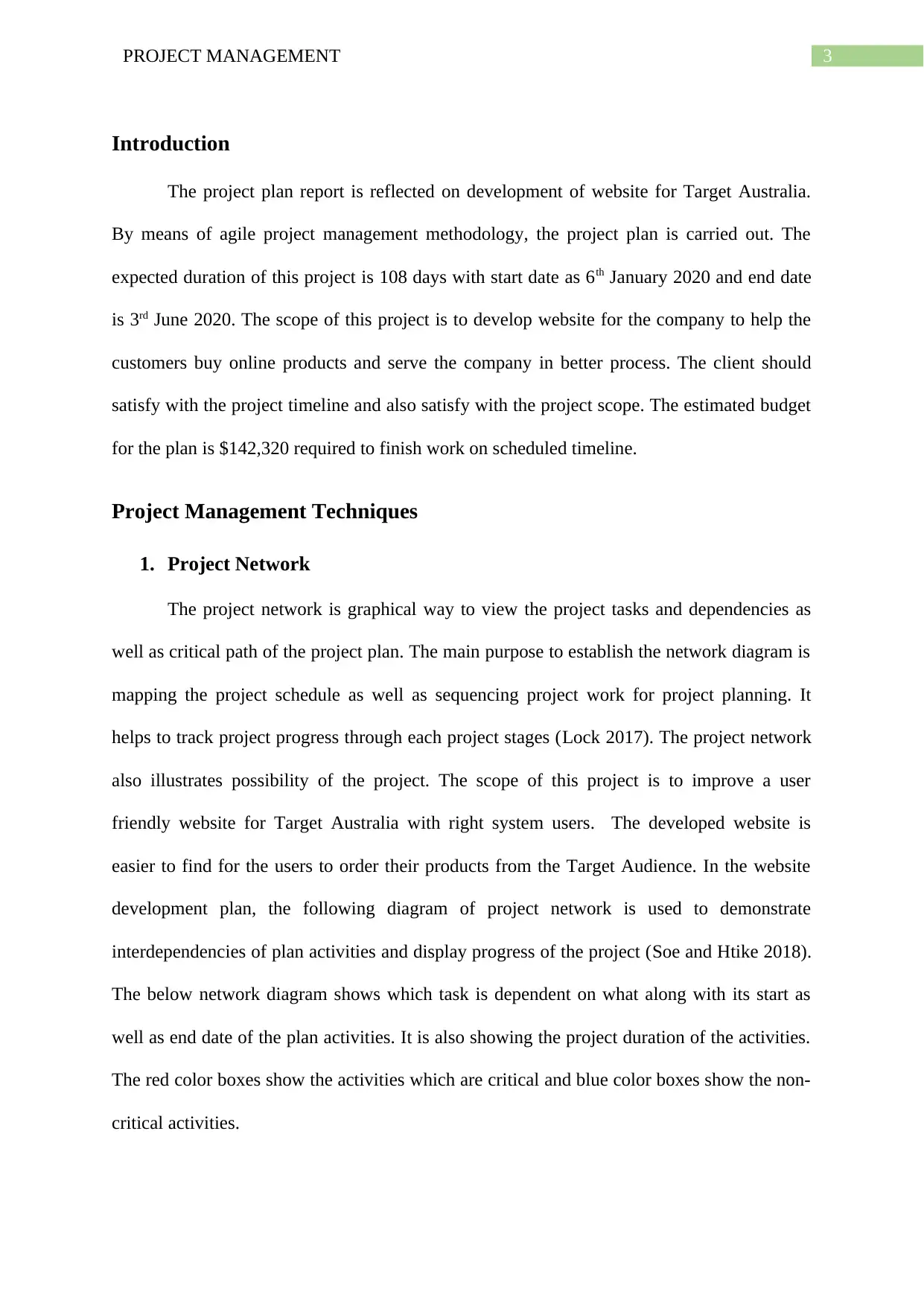
3PROJECT MANAGEMENT
Introduction
The project plan report is reflected on development of website for Target Australia.
By means of agile project management methodology, the project plan is carried out. The
expected duration of this project is 108 days with start date as 6th January 2020 and end date
is 3rd June 2020. The scope of this project is to develop website for the company to help the
customers buy online products and serve the company in better process. The client should
satisfy with the project timeline and also satisfy with the project scope. The estimated budget
for the plan is $142,320 required to finish work on scheduled timeline.
Project Management Techniques
1. Project Network
The project network is graphical way to view the project tasks and dependencies as
well as critical path of the project plan. The main purpose to establish the network diagram is
mapping the project schedule as well as sequencing project work for project planning. It
helps to track project progress through each project stages (Lock 2017). The project network
also illustrates possibility of the project. The scope of this project is to improve a user
friendly website for Target Australia with right system users. The developed website is
easier to find for the users to order their products from the Target Audience. In the website
development plan, the following diagram of project network is used to demonstrate
interdependencies of plan activities and display progress of the project (Soe and Htike 2018).
The below network diagram shows which task is dependent on what along with its start as
well as end date of the plan activities. It is also showing the project duration of the activities.
The red color boxes show the activities which are critical and blue color boxes show the non-
critical activities.
Introduction
The project plan report is reflected on development of website for Target Australia.
By means of agile project management methodology, the project plan is carried out. The
expected duration of this project is 108 days with start date as 6th January 2020 and end date
is 3rd June 2020. The scope of this project is to develop website for the company to help the
customers buy online products and serve the company in better process. The client should
satisfy with the project timeline and also satisfy with the project scope. The estimated budget
for the plan is $142,320 required to finish work on scheduled timeline.
Project Management Techniques
1. Project Network
The project network is graphical way to view the project tasks and dependencies as
well as critical path of the project plan. The main purpose to establish the network diagram is
mapping the project schedule as well as sequencing project work for project planning. It
helps to track project progress through each project stages (Lock 2017). The project network
also illustrates possibility of the project. The scope of this project is to improve a user
friendly website for Target Australia with right system users. The developed website is
easier to find for the users to order their products from the Target Audience. In the website
development plan, the following diagram of project network is used to demonstrate
interdependencies of plan activities and display progress of the project (Soe and Htike 2018).
The below network diagram shows which task is dependent on what along with its start as
well as end date of the plan activities. It is also showing the project duration of the activities.
The red color boxes show the activities which are critical and blue color boxes show the non-
critical activities.
Paraphrase This Document
Need a fresh take? Get an instant paraphrase of this document with our AI Paraphraser
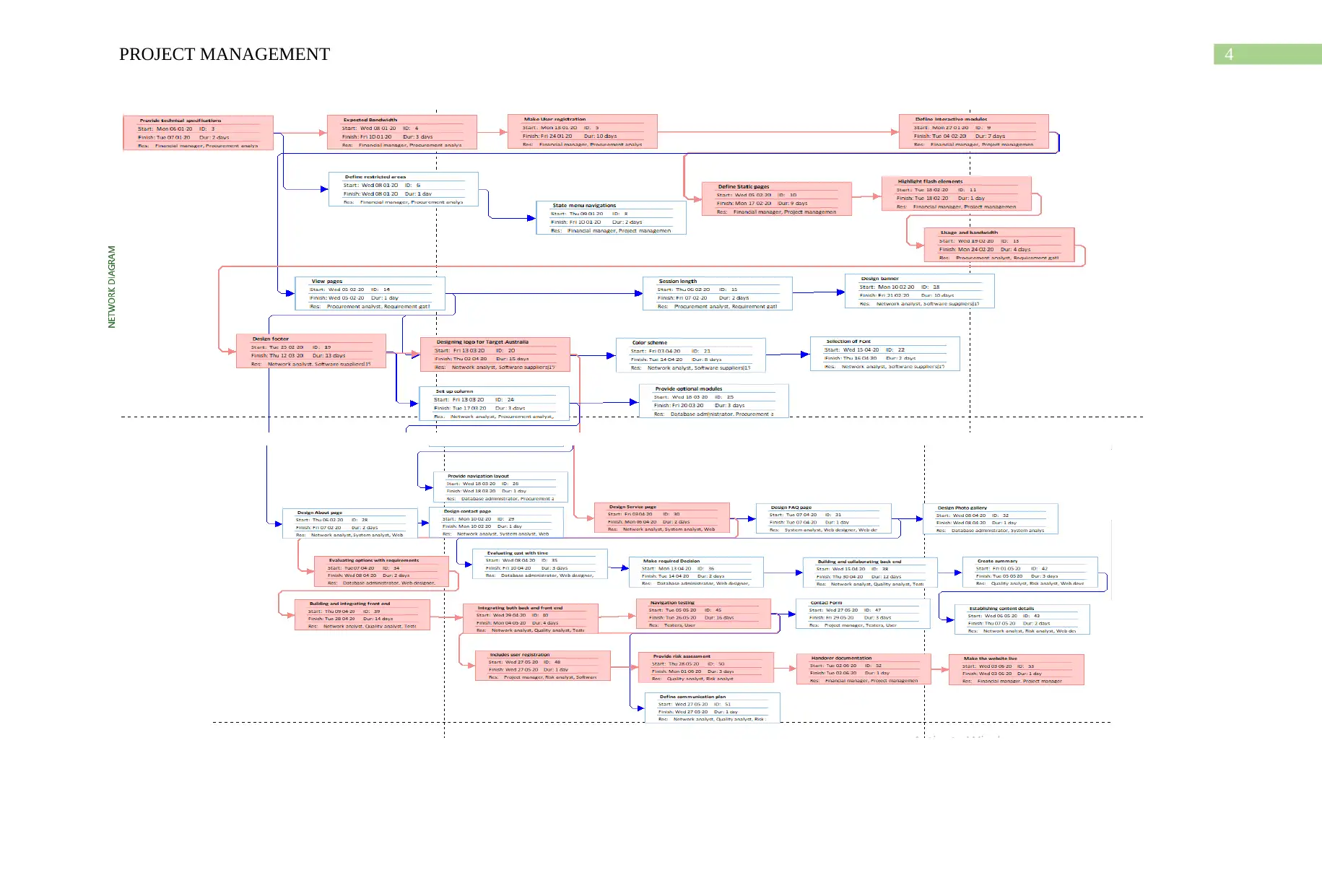
4PROJECT MANAGEMENT
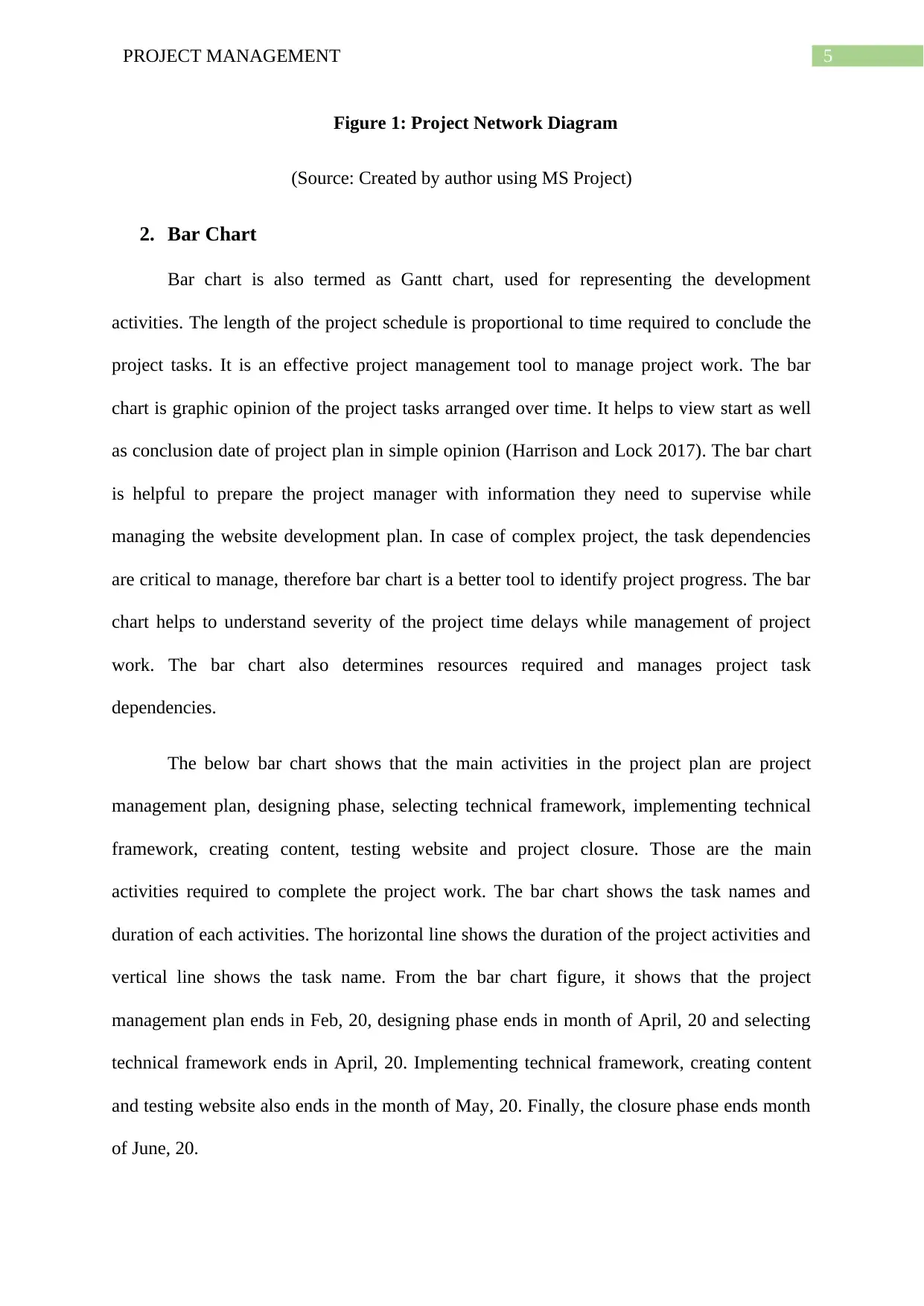
5PROJECT MANAGEMENT
Figure 1: Project Network Diagram
(Source: Created by author using MS Project)
2. Bar Chart
Bar chart is also termed as Gantt chart, used for representing the development
activities. The length of the project schedule is proportional to time required to conclude the
project tasks. It is an effective project management tool to manage project work. The bar
chart is graphic opinion of the project tasks arranged over time. It helps to view start as well
as conclusion date of project plan in simple opinion (Harrison and Lock 2017). The bar chart
is helpful to prepare the project manager with information they need to supervise while
managing the website development plan. In case of complex project, the task dependencies
are critical to manage, therefore bar chart is a better tool to identify project progress. The bar
chart helps to understand severity of the project time delays while management of project
work. The bar chart also determines resources required and manages project task
dependencies.
The below bar chart shows that the main activities in the project plan are project
management plan, designing phase, selecting technical framework, implementing technical
framework, creating content, testing website and project closure. Those are the main
activities required to complete the project work. The bar chart shows the task names and
duration of each activities. The horizontal line shows the duration of the project activities and
vertical line shows the task name. From the bar chart figure, it shows that the project
management plan ends in Feb, 20, designing phase ends in month of April, 20 and selecting
technical framework ends in April, 20. Implementing technical framework, creating content
and testing website also ends in the month of May, 20. Finally, the closure phase ends month
of June, 20.
Figure 1: Project Network Diagram
(Source: Created by author using MS Project)
2. Bar Chart
Bar chart is also termed as Gantt chart, used for representing the development
activities. The length of the project schedule is proportional to time required to conclude the
project tasks. It is an effective project management tool to manage project work. The bar
chart is graphic opinion of the project tasks arranged over time. It helps to view start as well
as conclusion date of project plan in simple opinion (Harrison and Lock 2017). The bar chart
is helpful to prepare the project manager with information they need to supervise while
managing the website development plan. In case of complex project, the task dependencies
are critical to manage, therefore bar chart is a better tool to identify project progress. The bar
chart helps to understand severity of the project time delays while management of project
work. The bar chart also determines resources required and manages project task
dependencies.
The below bar chart shows that the main activities in the project plan are project
management plan, designing phase, selecting technical framework, implementing technical
framework, creating content, testing website and project closure. Those are the main
activities required to complete the project work. The bar chart shows the task names and
duration of each activities. The horizontal line shows the duration of the project activities and
vertical line shows the task name. From the bar chart figure, it shows that the project
management plan ends in Feb, 20, designing phase ends in month of April, 20 and selecting
technical framework ends in April, 20. Implementing technical framework, creating content
and testing website also ends in the month of May, 20. Finally, the closure phase ends month
of June, 20.
⊘ This is a preview!⊘
Do you want full access?
Subscribe today to unlock all pages.

Trusted by 1+ million students worldwide
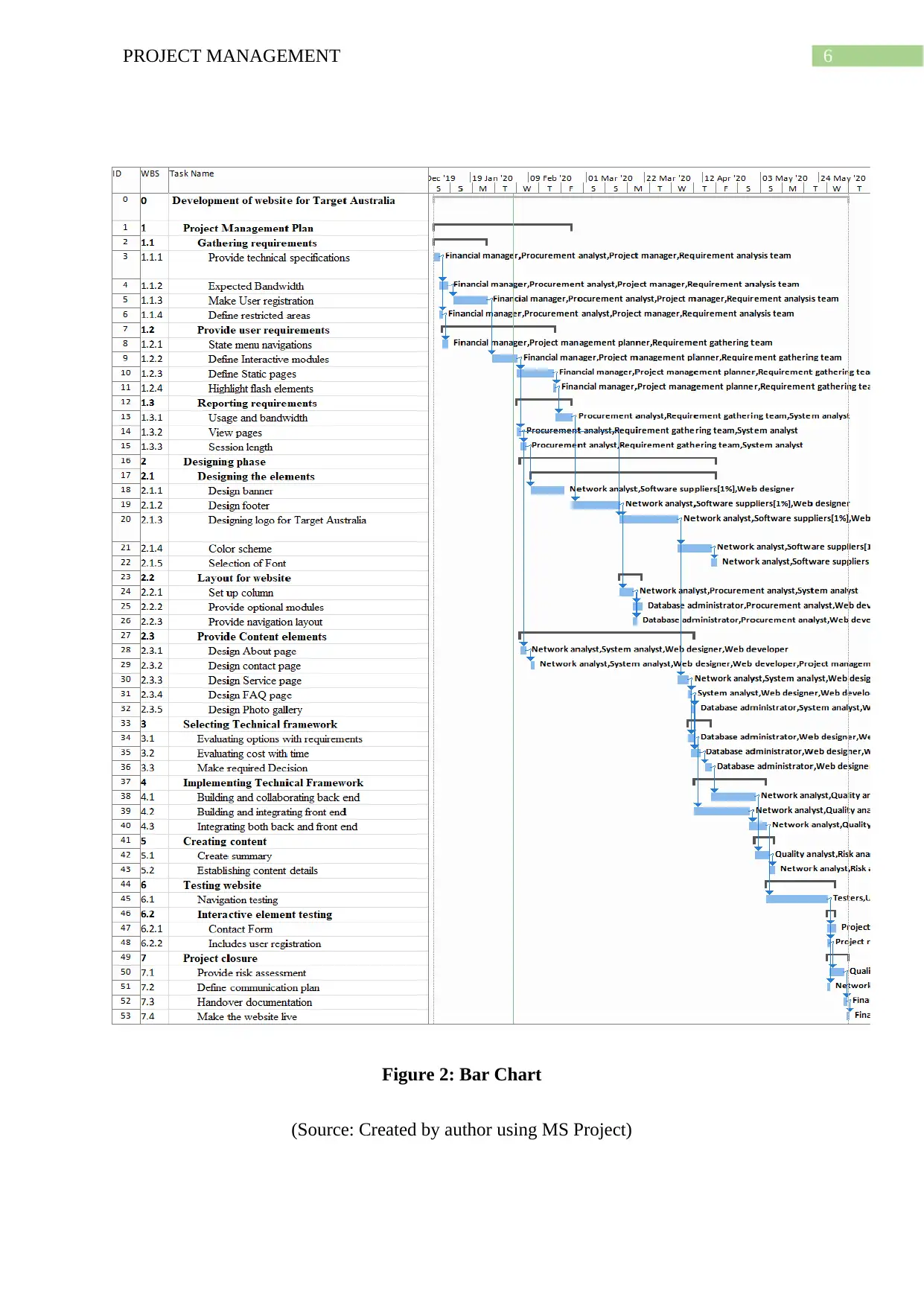
6PROJECT MANAGEMENT
Figure 2: Bar Chart
(Source: Created by author using MS Project)
Figure 2: Bar Chart
(Source: Created by author using MS Project)
Paraphrase This Document
Need a fresh take? Get an instant paraphrase of this document with our AI Paraphraser
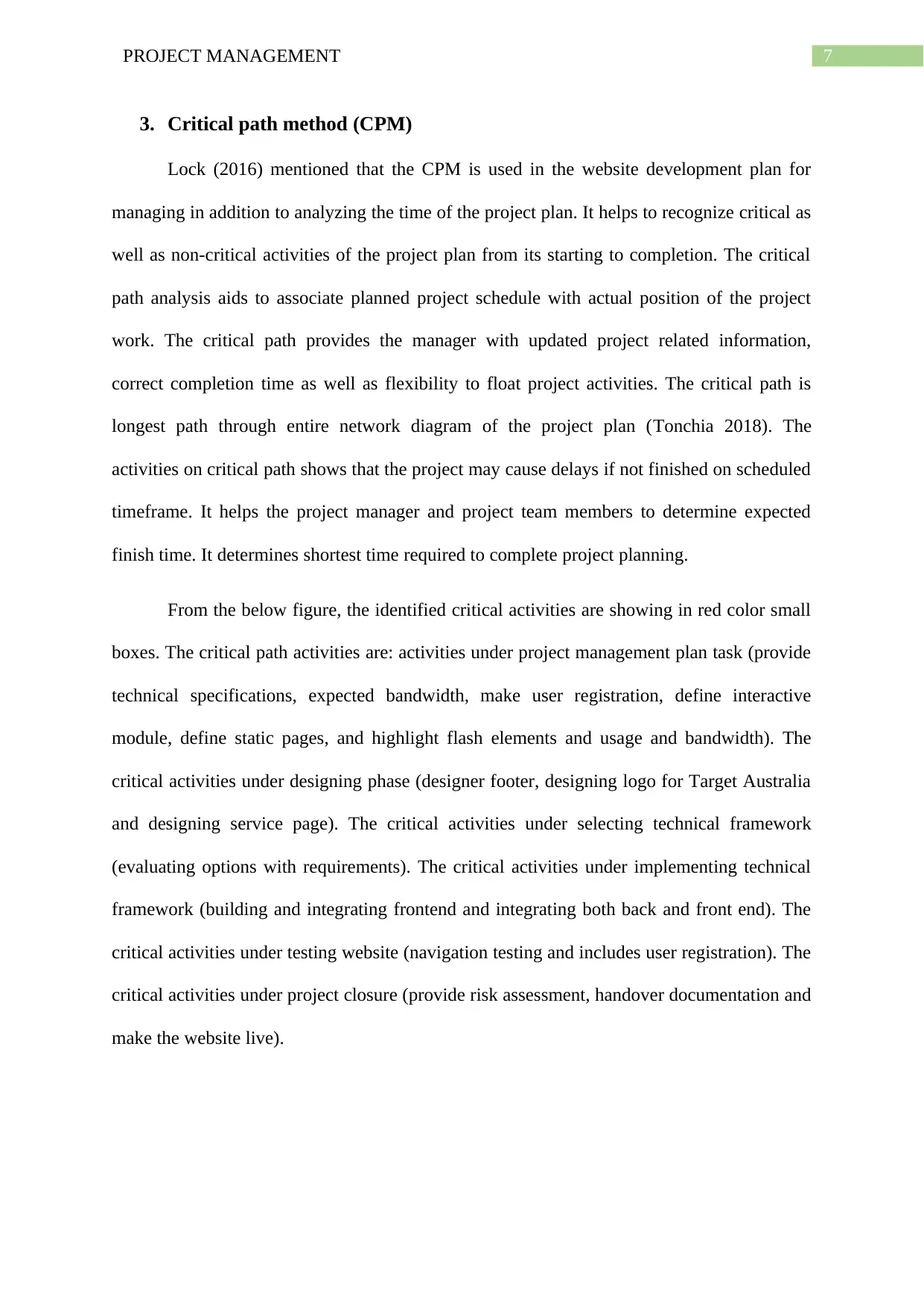
7PROJECT MANAGEMENT
3. Critical path method (CPM)
Lock (2016) mentioned that the CPM is used in the website development plan for
managing in addition to analyzing the time of the project plan. It helps to recognize critical as
well as non-critical activities of the project plan from its starting to completion. The critical
path analysis aids to associate planned project schedule with actual position of the project
work. The critical path provides the manager with updated project related information,
correct completion time as well as flexibility to float project activities. The critical path is
longest path through entire network diagram of the project plan (Tonchia 2018). The
activities on critical path shows that the project may cause delays if not finished on scheduled
timeframe. It helps the project manager and project team members to determine expected
finish time. It determines shortest time required to complete project planning.
From the below figure, the identified critical activities are showing in red color small
boxes. The critical path activities are: activities under project management plan task (provide
technical specifications, expected bandwidth, make user registration, define interactive
module, define static pages, and highlight flash elements and usage and bandwidth). The
critical activities under designing phase (designer footer, designing logo for Target Australia
and designing service page). The critical activities under selecting technical framework
(evaluating options with requirements). The critical activities under implementing technical
framework (building and integrating frontend and integrating both back and front end). The
critical activities under testing website (navigation testing and includes user registration). The
critical activities under project closure (provide risk assessment, handover documentation and
make the website live).
3. Critical path method (CPM)
Lock (2016) mentioned that the CPM is used in the website development plan for
managing in addition to analyzing the time of the project plan. It helps to recognize critical as
well as non-critical activities of the project plan from its starting to completion. The critical
path analysis aids to associate planned project schedule with actual position of the project
work. The critical path provides the manager with updated project related information,
correct completion time as well as flexibility to float project activities. The critical path is
longest path through entire network diagram of the project plan (Tonchia 2018). The
activities on critical path shows that the project may cause delays if not finished on scheduled
timeframe. It helps the project manager and project team members to determine expected
finish time. It determines shortest time required to complete project planning.
From the below figure, the identified critical activities are showing in red color small
boxes. The critical path activities are: activities under project management plan task (provide
technical specifications, expected bandwidth, make user registration, define interactive
module, define static pages, and highlight flash elements and usage and bandwidth). The
critical activities under designing phase (designer footer, designing logo for Target Australia
and designing service page). The critical activities under selecting technical framework
(evaluating options with requirements). The critical activities under implementing technical
framework (building and integrating frontend and integrating both back and front end). The
critical activities under testing website (navigation testing and includes user registration). The
critical activities under project closure (provide risk assessment, handover documentation and
make the website live).
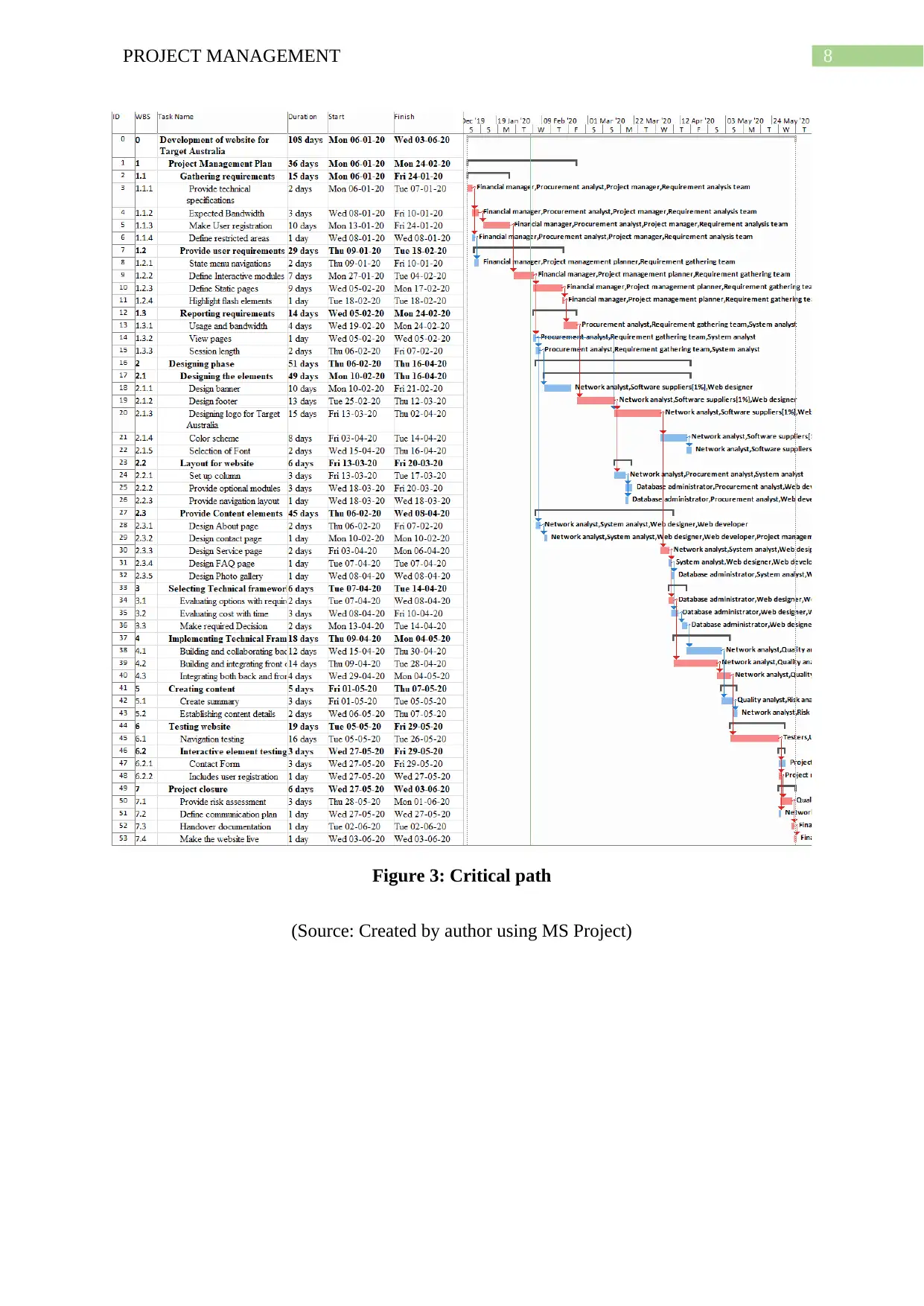
8PROJECT MANAGEMENT
Figure 3: Critical path
(Source: Created by author using MS Project)
Figure 3: Critical path
(Source: Created by author using MS Project)
⊘ This is a preview!⊘
Do you want full access?
Subscribe today to unlock all pages.

Trusted by 1+ million students worldwide
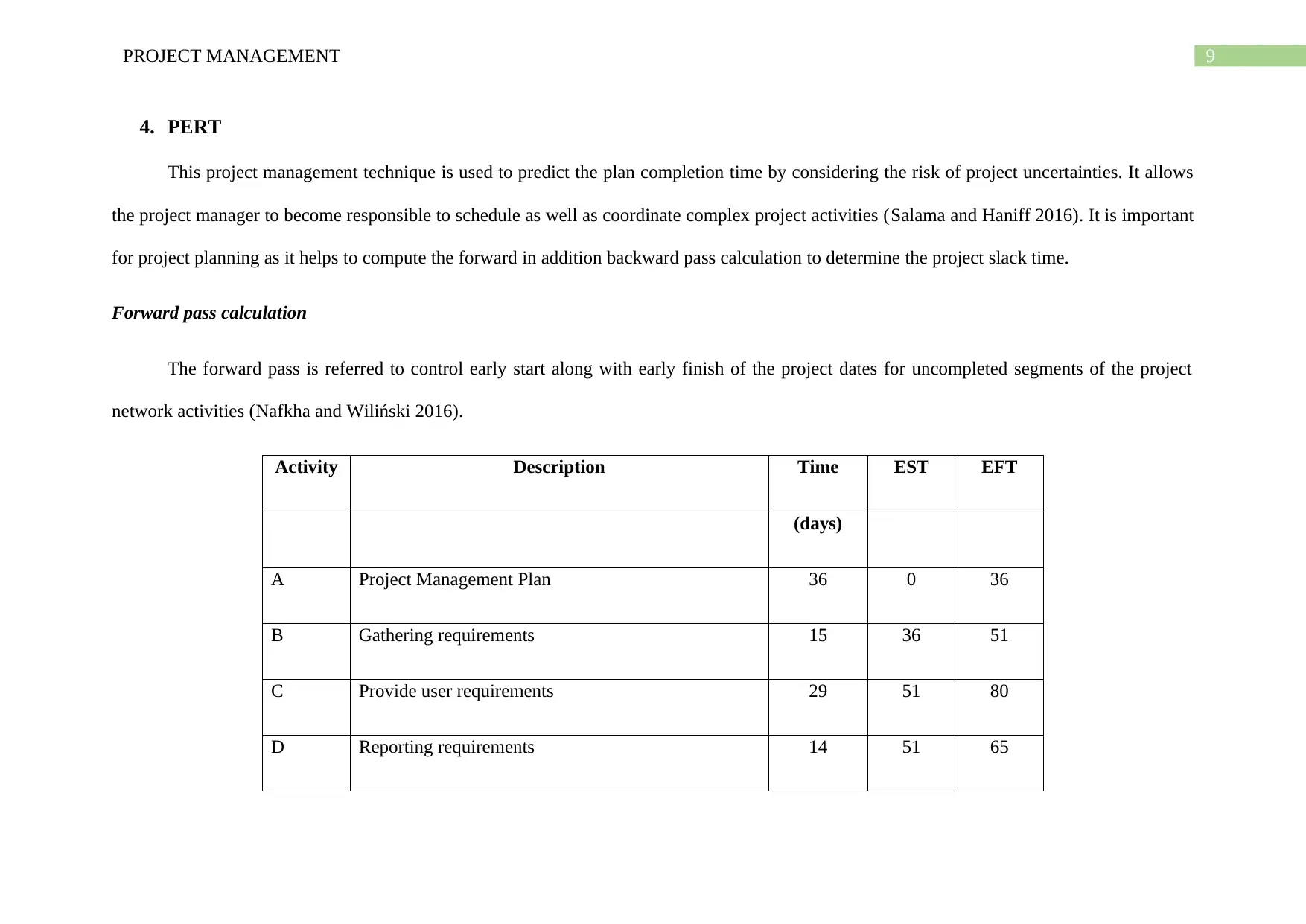
9PROJECT MANAGEMENT
4. PERT
This project management technique is used to predict the plan completion time by considering the risk of project uncertainties. It allows
the project manager to become responsible to schedule as well as coordinate complex project activities (Salama and Haniff 2016). It is important
for project planning as it helps to compute the forward in addition backward pass calculation to determine the project slack time.
Forward pass calculation
The forward pass is referred to control early start along with early finish of the project dates for uncompleted segments of the project
network activities (Nafkha and Wiliński 2016).
Activity Description Time EST EFT
(days)
A Project Management Plan 36 0 36
B Gathering requirements 15 36 51
C Provide user requirements 29 51 80
D Reporting requirements 14 51 65
4. PERT
This project management technique is used to predict the plan completion time by considering the risk of project uncertainties. It allows
the project manager to become responsible to schedule as well as coordinate complex project activities (Salama and Haniff 2016). It is important
for project planning as it helps to compute the forward in addition backward pass calculation to determine the project slack time.
Forward pass calculation
The forward pass is referred to control early start along with early finish of the project dates for uncompleted segments of the project
network activities (Nafkha and Wiliński 2016).
Activity Description Time EST EFT
(days)
A Project Management Plan 36 0 36
B Gathering requirements 15 36 51
C Provide user requirements 29 51 80
D Reporting requirements 14 51 65
Paraphrase This Document
Need a fresh take? Get an instant paraphrase of this document with our AI Paraphraser
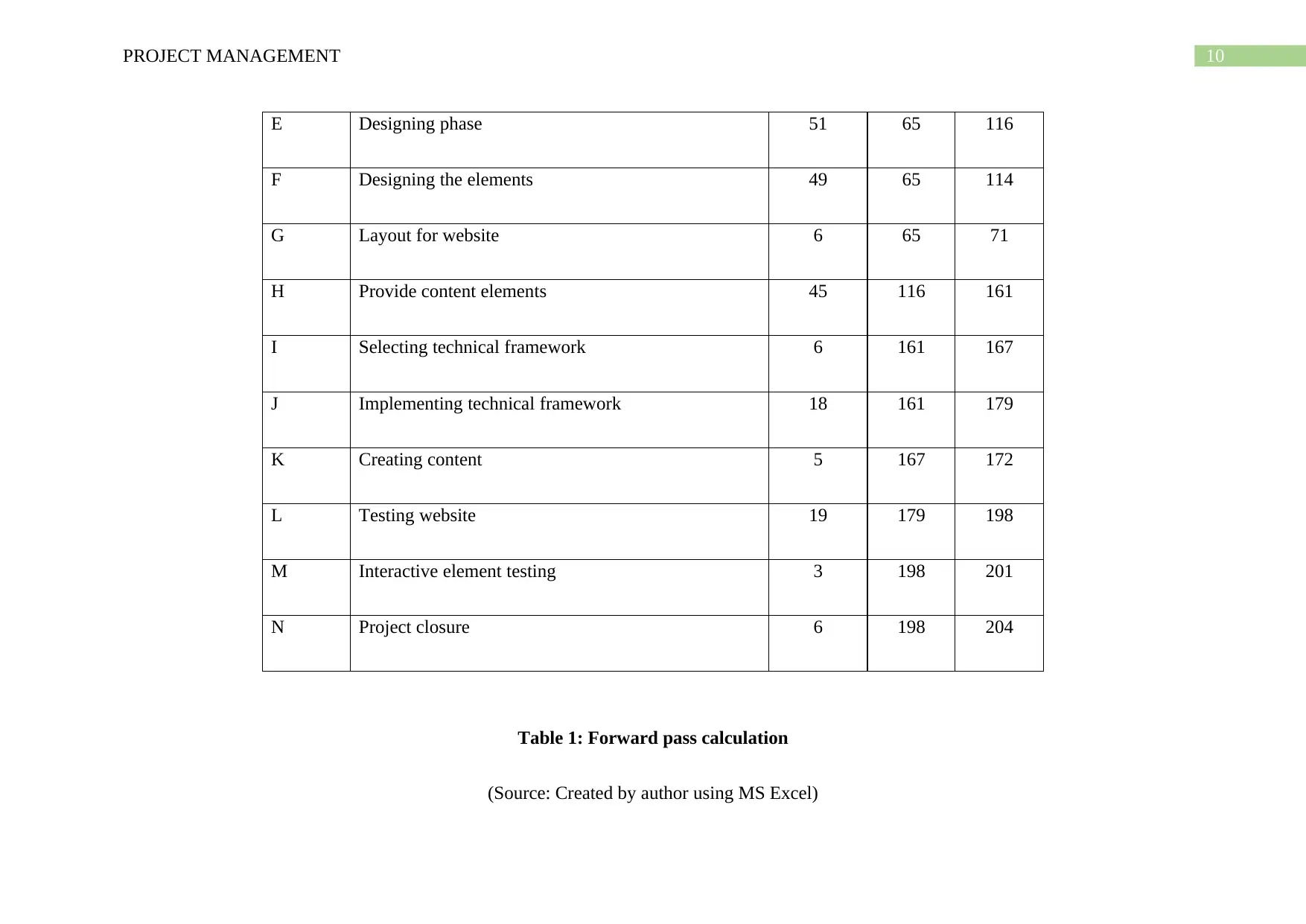
10PROJECT MANAGEMENT
E Designing phase 51 65 116
F Designing the elements 49 65 114
G Layout for website 6 65 71
H Provide content elements 45 116 161
I Selecting technical framework 6 161 167
J Implementing technical framework 18 161 179
K Creating content 5 167 172
L Testing website 19 179 198
M Interactive element testing 3 198 201
N Project closure 6 198 204
Table 1: Forward pass calculation
(Source: Created by author using MS Excel)
E Designing phase 51 65 116
F Designing the elements 49 65 114
G Layout for website 6 65 71
H Provide content elements 45 116 161
I Selecting technical framework 6 161 167
J Implementing technical framework 18 161 179
K Creating content 5 167 172
L Testing website 19 179 198
M Interactive element testing 3 198 201
N Project closure 6 198 204
Table 1: Forward pass calculation
(Source: Created by author using MS Excel)
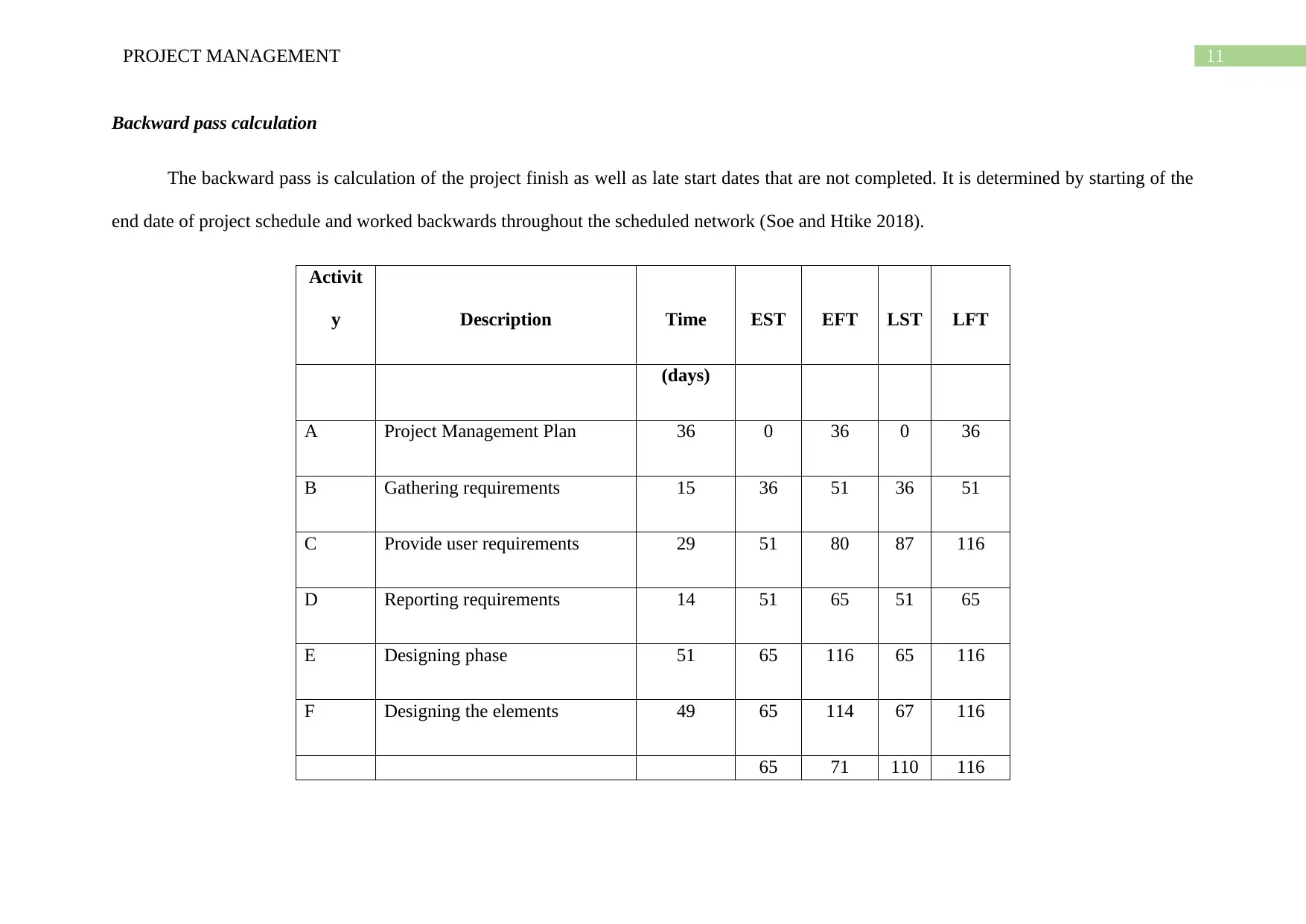
11PROJECT MANAGEMENT
Backward pass calculation
The backward pass is calculation of the project finish as well as late start dates that are not completed. It is determined by starting of the
end date of project schedule and worked backwards throughout the scheduled network (Soe and Htike 2018).
Activit
y Description Time EST EFT LST LFT
(days)
A Project Management Plan 36 0 36 0 36
B Gathering requirements 15 36 51 36 51
C Provide user requirements 29 51 80 87 116
D Reporting requirements 14 51 65 51 65
E Designing phase 51 65 116 65 116
F Designing the elements 49 65 114 67 116
65 71 110 116
Backward pass calculation
The backward pass is calculation of the project finish as well as late start dates that are not completed. It is determined by starting of the
end date of project schedule and worked backwards throughout the scheduled network (Soe and Htike 2018).
Activit
y Description Time EST EFT LST LFT
(days)
A Project Management Plan 36 0 36 0 36
B Gathering requirements 15 36 51 36 51
C Provide user requirements 29 51 80 87 116
D Reporting requirements 14 51 65 51 65
E Designing phase 51 65 116 65 116
F Designing the elements 49 65 114 67 116
65 71 110 116
⊘ This is a preview!⊘
Do you want full access?
Subscribe today to unlock all pages.

Trusted by 1+ million students worldwide
1 out of 23
Related Documents
Your All-in-One AI-Powered Toolkit for Academic Success.
+13062052269
info@desklib.com
Available 24*7 on WhatsApp / Email
![[object Object]](/_next/static/media/star-bottom.7253800d.svg)
Unlock your academic potential
Copyright © 2020–2025 A2Z Services. All Rights Reserved. Developed and managed by ZUCOL.





